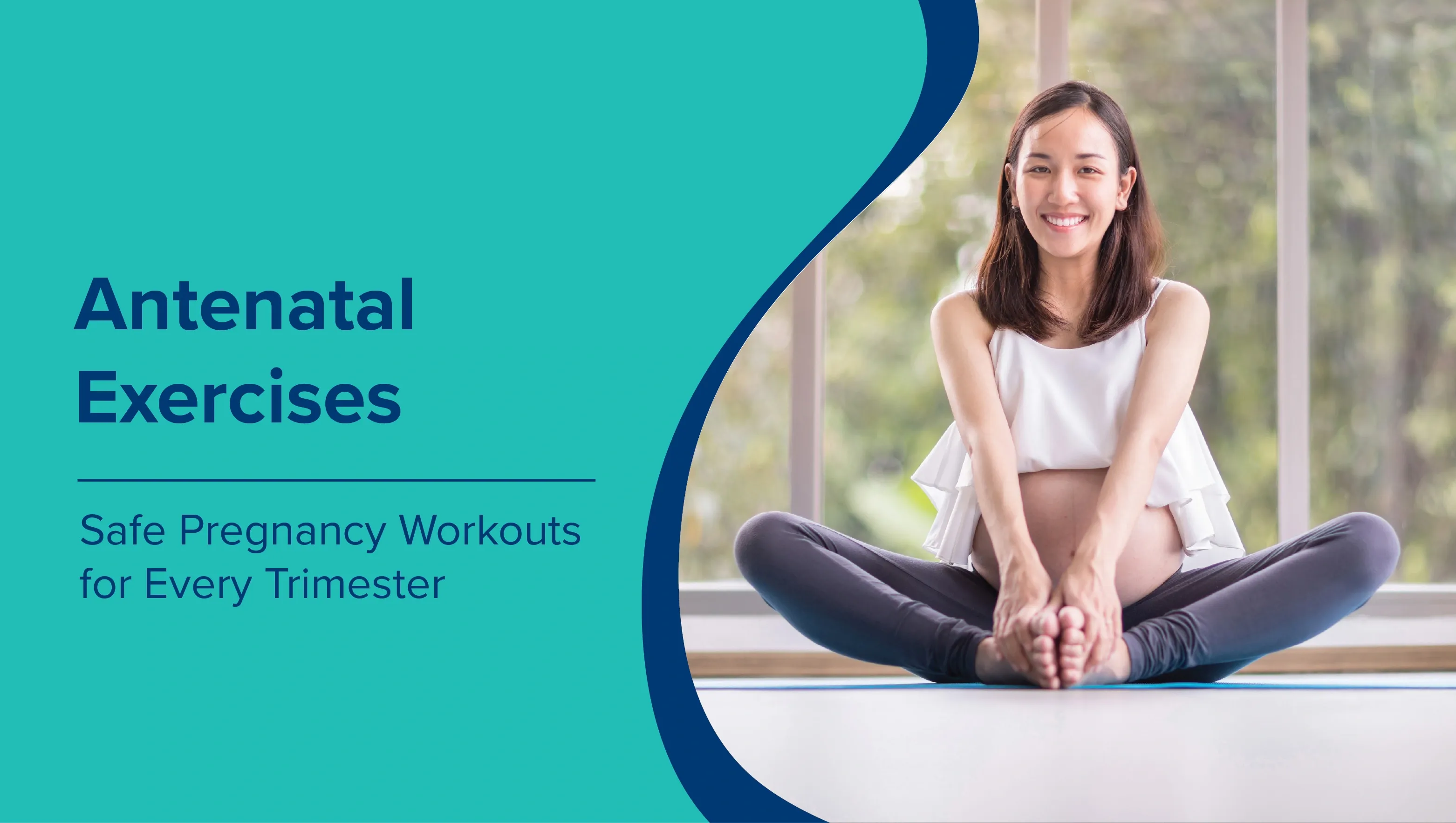Pregnancy is a time of immense change, both physically and emotionally. While rest is important, staying active through safe antenatal exercises can make a world of difference. Gentle, trimester-specific workouts not only support your body’s changing needs but also help reduce discomfort, boost energy, and prepare you for labour. From simple stretches to strengthening routines, antenatal exercises promote better posture, improve circulation, and aid in maintaining overall well-being - all while keeping your baby’s safety in mind. To guide expecting mothers, in this article, we’ll cover the benefits of antenatal exercises, safe trimester-wise workouts, physiotherapy-guided routines, precautions, and simple at-home exercises. Let’s start by understanding the fundamentals of antenatal exercises.
What are Antenatal Exercises?
Antenatal exercises are safe, specially designed workouts for women during pregnancy that focus on improving strength, flexibility, and endurance while preparing the body for childbirth. Unlike general fitness routines, these exercises are adapted to match the body’s changing needs across trimesters.
They not only help in reducing common discomforts such as back pain, swelling, or fatigue but also promote better posture and circulation. Most importantly, antenatal exercises contribute to smoother labour and quicker recovery after delivery.
Since every pregnancy is different, it is important to seek medical guidance before starting a workout plan. A quick doctor visit ensures that the exercises chosen are safe for the mother and baby, especially in high-risk pregnancies.
Benefits of Pregnancy Exercises for Mother and Baby
Exercising during pregnancy offers benefits that extend to both the mother and the developing baby. With the right antenatal workout plan, women can experience greater comfort and improved health throughout their pregnancy.
For mothers, antenatal exercises can:
- Reduce back pain, swelling, and muscle stiffness
- Improve posture and circulation
- Boost stamina and energy levels
- Promote better sleep and reduce stress
- Support healthy weight management
For babies, maternal exercise can:
- Enhance blood flow and oxygen supply
- Support healthy growth and development
- Lower the risk of complications during labour and delivery
Alongside antenatal fitness, mothers can also benefit from postpartum support. Services such as Japa Maid Service provide essential care after delivery, complementing the advantages of antenatal exercise by ensuring proper recovery and newborn care.
Types of Antenatal Exercises You Should Know
A variety of antenatal exercises can be safely practised during pregnancy, each serving a specific purpose in supporting the body’s changes and preparing for childbirth. These exercises are best performed under professional guidance, especially for first-time mothers.
Common types of antenatal exercises include:
-
Stretching and flexibility exercises: Gentle stretches help relieve muscle tightness, improve mobility, and reduce stiffness.
-
Strength and resistance exercises: Light weights or resistance bands strengthen muscles that support the back, hips, and pelvic floor.
-
Breathing and relaxation techniques: Deep breathing and guided relaxation reduce stress, improve oxygen supply, and prepare the body for labour.
-
Yoga and modified Pilates: Promote balance, posture, and flexibility while being adapted for pregnancy safety.
-
Pregnancy physiotherapy exercises: Tailored by a physiotherapist to manage pain, improve posture, and enhance mobility throughout pregnancy.
Professional physiotherapy guidance ensures that these exercises are performed correctly, minimising the risk of injury and maximising their benefits.
Exercise and Pregnancy: How the Body Changes Trimester-Wise
Pregnancy brings gradual but significant physical changes, and understanding them helps in choosing the right antenatal exercises at each stage.
-
First trimester: Hormonal shifts often cause fatigue, nausea, and low energy. Light activities such as walking, stretching, or gentle yoga are recommended.
-
Second trimester: As the belly grows, balance begins to change and the strain on the back increases. Low-impact workouts like swimming, stationary cycling, and pelvic floor exercises become more suitable.
-
Third trimester: The body feels heavier, mobility is limited, and shortness of breath is common. Gentle movements such as butterfly stretches, squats, and breathing exercises help prepare for labour.
By adapting exercises trimester by trimester, mothers can stay active safely and manage the changing demands of pregnancy more effectively.
Safe Antenatal Exercises by Trimester
Each stage of pregnancy has its own requirements, and choosing the right exercises ensures safety while maximising benefits.
First Trimester (0 - 3 months):
- Walking at a comfortable pace
- Gentle stretching routines
- Light yoga with modified poses
Second Trimester (4 - 6 months):
- Swimming or water aerobics for low-impact fitness
- Stationary cycling to improve stamina without strain
- Pelvic floor (Kegel) exercises for labour preparation
Third Trimester (7 - 9 months):
- Butterfly pose to improve hip and pelvic flexibility
- Supported squats to strengthen lower body muscles
- Breathing and relaxation techniques to prepare for delivery
These safe routines can be practised regularly, but they should always be adjusted to energy levels and comfort, with medical approval when needed.
Pregnancy Exercise Chart: Weekly Antenatal Workout Plan
A structured plan helps expectant mothers stay consistent and balanced in their workouts. Below is a sample weekly antenatal workout chart that combines light cardio, strength, flexibility, and relaxation.
|
Day |
Recommended Workout |
Duration |
|
Monday |
Walking + Gentle stretching |
20–30 minutes |
|
Tuesday |
Pelvic floor (Kegels) + Breathing exercises |
15–20 minutes |
|
Wednesday |
Swimming / Stationary cycling |
20–30 minutes |
|
Thursday |
Yoga (modified pregnancy poses) |
20 minutes |
|
Friday |
Light strength training (resistance bands/ bodyweight) |
15–20 minutes |
|
Saturday |
Butterfly exercise + Relaxation/meditation |
20 minutes |
|
Sunday |
Rest or light walking |
As comfortable |
Note: This chart is flexible and should be tailored based on the trimester, overall health, and comfort levels. Regularity is more important than intensity, and all exercises should be performed safely with proper warm-up and cool-down.
Physiotherapy and Specialised Exercises During Pregnancy
Certain exercises during pregnancy require professional guidance, especially for managing pain, improving mobility, and preparing the body for childbirth. Physiotherapy-based routines and specialised moves can make a significant difference in comfort and recovery.
Physiotherapy-guided exercises may include:
-
Posture correction routines to ease back and neck strain
-
Gentle strengthening exercises for the pelvic floor and abdominal muscles
-
Mobility exercises to reduce joint stiffness and improve flexibility
Specialised antenatal exercises include:
-
Butterfly exercise: Improves pelvic flexibility and prepares the hips for labour.
-
Pelvic floor (Kegel) exercises: Strengthen the pelvic muscles, reducing incontinence and supporting normal delivery.
-
Modified abdominal exercises: Safe core workouts that help maintain stability and prevent back pain.
Practising these exercises under the supervision of a trained physiotherapist ensures safety while maximising benefits for both mother and baby.
Safety and Precautions for Antenatal Workouts
While exercise during pregnancy is beneficial, it must always be done with care. Following safety guidelines helps prevent strain or complications.
General tips for safe pregnancy exercises:
-
Always warm up and cool down to avoid muscle injury
-
Stay hydrated and avoid overheating
-
Wear comfortable clothing and supportive footwear
-
Exercise in a safe environment to reduce fall risks
-
Keep intensity moderate - avoid breathlessness or exhaustion
Exercises to avoid during pregnancy:
-
High-impact or contact sports (e.g., basketball, skiing)
-
Activities with a risk of falling (cycling outdoors, horseback riding)
-
Heavy weightlifting or exercises lying flat on the back after the first trimester
-
Deep abdominal twists or extreme stretches
Warning signs to stop exercising immediately:
-
Vaginal bleeding or fluid leakage
-
Severe abdominal or chest pain
-
Dizziness, fainting, or shortness of breath
-
Persistent contractions or decreased foetal movement
Listening to the body and seeking medical advice promptly ensures exercise remains safe and effective throughout pregnancy.
Antenatal vs Postnatal Exercises
Antenatal exercises not only support a healthy pregnancy but also prepare the body for the demands of childbirth. They strengthen the pelvic floor, improve stamina, and help maintain flexibility, all of which ease labour and delivery.
Postnatal exercises, on the other hand, focus on recovery after childbirth. Gentle movements, breathing exercises, and pelvic floor strengthening help restore muscle tone, reduce back pain, and improve overall energy. Gradually, women can return to light strength training and flexibility routines under guidance.
Together, antenatal and postnatal workouts provide a complete cycle of care, building strength during pregnancy and restoring it after delivery for long-term health and well-being.
Myths and Facts About Exercising During Pregnancy
There are many misconceptions around pregnancy workouts, which often discourage women from staying active. Separating myths from facts helps expectant mothers make informed decisions.
-
Myth: Exercise can harm the baby.
Fact: Safe antenatal exercises support foetal growth by improving blood flow and oxygen supply. -
Myth: Pregnant women should only rest.
Fact: Moderate activity reduces discomfort, improves energy, and prepares the body for labour. -
Myth: Lifting anything during pregnancy is unsafe.
Fact: Heavy lifting should be avoided, but light strength exercises approved by a doctor or physiotherapist are safe and beneficial. -
Myth: Exercise increases the risk of miscarriage.
Fact: Low to moderate-intensity workouts recommended for pregnancy are safe and help in maintaining maternal health.
Why Choose MaxAtHome for Antenatal Care Support?
Staying active during pregnancy becomes easier with the right professional support at home. MaxAtHome provides trusted antenatal care services that combine convenience of home with expert guidance. We offer:
-
At-home physiotherapy for pregnancy comfort: Safe and customised physiotherapy sessions delivered at home to relieve back pain, improve mobility, and guide antenatal exercises without travelling to a clinic.
-
At-home doctor visit/consultation for safe pregnancy exercise planning: Convenient access to medical experts who can review health status and guide mothers in starting or adjusting their antenatal workout routines safely for each trimester.
-
Postnatal and Japa Maid care at home for recovery:Home-based nursing and Japa Maid services support new mothers with recovery, diet, and newborn care after delivery.
-
Hospital-quality care in the comfort of home: Experienced healthcare professionals ensure trusted, safe, and convenient pregnancy support at home.
Book Antenatal Care Support with MaxAtHome
Safe exercise and physiotherapy during pregnancy can make a meaningful difference in both comfort and delivery preparation. With MaxAtHome, mothers now have access to expert guidance, physiotherapy sessions, and postnatal care right at the comfort of their home.
To book antenatal physiotherapy or pregnancy care services at home, call 9240299624 or schedule an appointment through our easy-to-use booking platform.
Frequently Asked Questions (FAQs)
What are the third trimester exercises for easy birth and labour preparation?
Gentle squats, butterfly pose, pelvic floor (Kegel) exercises, and breathing techniques help strengthen the body and prepare for labour.
What exercises are unsafe during pregnancy?
High-impact sports, activities with a risk of falling, heavy lifting, and exercises lying flat on the back after the first trimester should be avoided.
Can a pregnant woman exercise in the first trimester?
Yes, light activities such as walking, stretching, and gentle yoga are safe, but it is best to consult a doctor before starting.
Is strenuous exercise dangerous during pregnancy?
Yes, strenuous workouts can increase risks. Moderate-intensity routines tailored for pregnancy are safer and more effective.
What exercises can a pregnant woman do at home?
Walking indoors, pelvic floor exercises, butterfly stretches, and simple breathing routines are safe to practise at home.
When should I start antenatal exercises?
Antenatal exercises can begin in the first trimester if the pregnancy is healthy, but always under medical guidance.
What are signs I should stop exercising when pregnant?
Stop immediately if there is vaginal bleeding, severe abdominal pain, dizziness, chest pain, or decreased foetal movement.
Can weak pelvic floor muscles cause early labour?
A weak pelvic floor usually does not trigger early labour but may lead to urinary incontinence and delivery complications. Strengthening exercises help prevent this.
Can pelvic floor exercises prevent tearing?
Yes, regular pelvic floor strengthening improves flexibility and control, which may reduce the risk of tearing during delivery.
What happens if you don’t do pelvic floor exercises during pregnancy?
Skipping them may increase the chances of pelvic floor weakness, urinary leakage, and slower postnatal recovery.
What are pregnancy physiotherapy exercises?
These include posture correction, gentle strengthening, stretching, and mobility exercises tailored to pregnancy needs by a physiotherapist.
Can antenatal exercises help with back pain during pregnancy?
Yes, physiotherapy-guided stretching, pelvic tilts, and strengthening routines are effective in reducing pregnancy-related back pain.
Is it okay to do butterfly exercise during pregnancy?
Yes, the butterfly exercise is safe and recommended in the later months to improve pelvic flexibility and prepare for labour.
What are antenatal and postnatal exercises?
Antenatal exercises prepare the body for pregnancy and childbirth, while postnatal exercises focus on recovery, strength, and flexibility after delivery.
Is it safe to exercise in the 4th, 5th, or 7th month of pregnancy?
Yes, safe exercises can be done in all months of pregnancy, but they should be modified according to the stage and always approved by a doctor.















